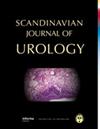Editorial comment to "Implementation of sacral neuromodulation for urinary indication. A Danish prospective cohort study from the first 15 months" by Kobberø H, Andersen M, Andersen K, et al.
IF 1.4
4区 医学
Q3 UROLOGY & NEPHROLOGY
Scandinavian Journal of Urology
Pub Date : 2022-10-01
Epub Date: 2022-07-06
DOI:10.1080/21681805.2022.2094463
引用次数: 0
对 "针对泌尿系统适应症实施骶神经调节术。Kobberø H, Andersen M, Andersen K, et al.
本文章由计算机程序翻译,如有差异,请以英文原文为准。
求助全文
约1分钟内获得全文
求助全文
来源期刊

Scandinavian Journal of Urology
UROLOGY & NEPHROLOGY-
CiteScore
2.90
自引率
6.70%
发文量
70
期刊介绍:
Scandinavian Journal of Urology is a journal for the clinical urologist and publishes papers within all fields in clinical urology. Experimental papers related to clinical questions are also invited.Important reports with great news value are published promptly.
 求助内容:
求助内容: 应助结果提醒方式:
应助结果提醒方式:


